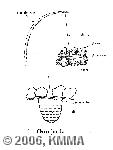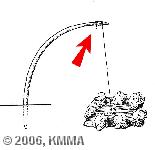


The ground bow is a stringed instrument made from a bent flexible branch 140-150 cm in length that is firmly fixed into the ground and to which a string is tied at the top.
The branch serves as a fretboard, and a round pit with a diameter of 20 cm and a depth of 30 cm is dug out next to it. A banana leaf, a piece of bark or similar material is stretched over the surface to create a soundboard. In the middle of this soundboard a hole is made for the string that is threaded through and tied to a perpendicular stick placed underneath the soundboard. This is wrapped around and held down with stones to create tension on the string.
To play the instrument, the player kneels or squats position. The string is plucked with the index finger and the thumb. Sometimes a stick is used as a plectrum. The other hand holds the end of the branch and the tone is altered by pulling down or stretching the string. Pulling the string downwards produces a low tone, and the reverse, pulling the string upwards, produces a higher tone. This can lead to a range of a fourth or even a fifth. The vibrating string can be dampened with the left hand.
The player normally sings or hums whilst playing the ground bow. He mostly plays as a soloist either for his own pleasure or for others. Children especially play the ground bow as a sort of game, sometimes also while herding cattle. In some tribes, such as the Mamvu, the instrument plays a role during hunting. The player sings about previous successful hunting episodes in the hope of summoning up the same sort of spirit for the pending hunt. Pits that serve as a soundboard for this kind of ground bow are of the same type as those used to hunt small mammals.
Laurenty, Costermans, Gansemans and Hulstaert have identified the use of the ground bow among the Mamvu, Mari Andosi, Apanga, Andekokte, Andekelao and Nepoko Pygmies, Balese, Tshamunonge, Mangbetu, Mondo, Boa, Barambo, Nkundo, Zande, Boloko, Bokote and the Luba.
This type of instrument is used in recordings of our sound archives made with the Congolese peoples mentioned hereafter where it appears with the following vernacular names:
Belumu (Pygmées), Bou (Efe), Dweme (Boma), Ekibulenge (Nande), Kadad (Lunda), Kitingbi (Efe), Lakwemi (Kuba), Lingungu (Lega), Lokombi (Bampe), Lokombi (Longombe) (Ekonda), Lokombi (Ngombi) (Badia, Sengele), Lokoombi (Boyela), Longofi (Mangbetu), Longombe (Bolia, Mongo), Longombi (Mongo), Lukungu (Luba, Pende), Lungungu (Kwese), Lunkombe (Luba-Kasai), Luntanta (Kanyoka), Lunzenze (Chokwe, Tshokwe), Lusuba (Luba), Mbela (Ngbaka), Mutefu (Luba-Kasai, Songye), Mutevu (lusuba) (Luba), Nedungu (Mangbetu), Nelingoti (Mangbetu), Ngomi (Boma), Nguem (Teke), Nkutu Kubidi (Luba), Nzenze (Shi), Rukung (Lunda), Umuduri (Rwanda), Zeze ((Wa) Nande)
Bibliography:
Discography:
© KMMA